Contains a genuine pencil
Just a little add-on to yesterday’s post:
Seen in a book store: Something I very often would have had a good use for in the past – and it contains a genuine pencil.

Contains a genuine pencil Read More »
Just a little add-on to yesterday’s post:
Seen in a book store: Something I very often would have had a good use for in the past – and it contains a genuine pencil.

Contains a genuine pencil Read More »
A pencil factory for Nigeria. If it really provides employment for 400,000 people it must be one heck of a factory.

A magazine that comes with pencils. Int he past I’ve only seen (and bought) ‘children magazines’ (Simpsons, Disney) that came with pencils.
A ‘graphite object’.
From the description:
Please Use! Functional Graphite Object writes like a pencil while resists staining your hands. Handcrafted using a proprietary technique that San Francisco artist Agelio Batle invented. With daily use they should last 7-9 years.

 Seen at the chemist [1]Not any old chemist, even a dispensing chemist.
Seen at the chemist [1]Not any old chemist, even a dispensing chemist.A crazy golf set – with one pencil, one golf putter eraser, three golf ball erasers and more.
Cheap Rhodia notebooks [2]Well, cheap for UK standards.. Only €1.20 for a Bloc Rhodia N° 12.
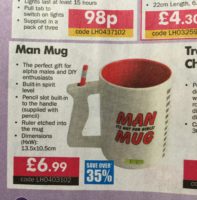 Seen in the catalogue of a distributor of electrical and related products
Seen in the catalogue of a distributor of electrical and related productsA Man Mug. Comes of course with a pencil!
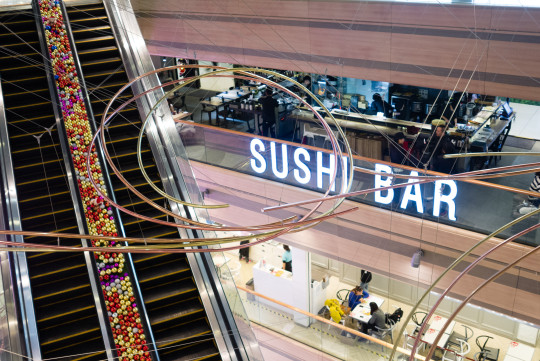
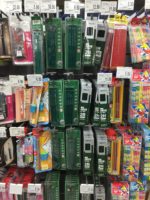
Yet another blog post related to my recent visit to Shanghai.
You might remember the Chung Hwa Drawing Pencil 101, together with the Chung Hwa 6151 it forms the pencil backbone of Shanghai. Whenever you see a pencil in Shanghai it usually is one of these two – and they are made in Shanghai, too.
…but what happened? Deli dared to enter Chung Hwa’s home turf – disturbing the natural order of things.
…and what a pencil they sent to threaten Chung Hwa’s hold on its home territory: it’s the Deli No.7083 [1]I assume the product number is derived from the last digits of the bar code before the heck digit …or maybe it’s the other way round..

I bought the 7083 in the Carrefour in Shanghai’s Hongkou Dragon Dream Shopping Centre and paid 11.80 元 (~$1.80; £1.25; €1.65) for a dozen HB pencils. They were also available in 2B and 2H.
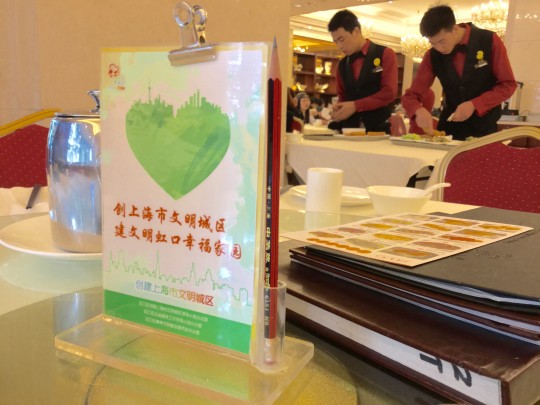
Let’s look at the appearance first. The 7083 looks like a pencil with a very thick layer of paint. The paint seems to be applied very well, except near the end of the pencil, which seems to have been dipped in just a bit too much paint. The 7083 has an unusually large diameter for a modern pencil. The paint job and the large diameter make it feel like a much better pencil than what you’d expect from a pencil with this price tag.

It is dark green like the Chung Hwa 101, but there’s also a similarity with another pencil. The shade of green used is virtually identical to the one used for the Castell 9000.

The 7083 lays down a very dark line and feels very smooth, even creamy when writing – but just to put this into context, we are talking about a very cheap pencil. The 7083 is not as good as the big boys, like the Mars Lumograph. Nevertheless it is very good and probably the best pencil I have tried in this price range.
If I had to compare to a pencil that is well known I would compare it to Staedtler’s Mars Lumograph in B. Point retention is very similar, but in direct comparison it is ever so slightly lighter than the Lumograph in B and slightly less smooth and erases slightly worse than the Lumograph in B [2]In case you wonder why, based in these statements, I don’t compare it to the Lumograph in HB: It is still much closer to the Lumograph in B, which shows you how minute these differences are. .
It writes well even on paper that is not good for non-soft pencils, like the original (‘Kraft’?) Field Notes.

The wood is slightly red, similar to the one used for the Chung Hwa 101 and when you knife sharpen the 7083 you notice that the wood is harder than cedar wood.

A great pencil that is nearly as good as much more expensive pencils. It has a strong paint smell, similar to other Chinese pencils, but for this price you probably won’t be able to find a much better pencil.
Price: December 2015
Exchange rates: January 2016
Please open images in a new tab/window to see them at full resolution.
References
| ↑1 | I assume the product number is derived from the last digits of the bar code before the heck digit …or maybe it’s the other way round. |
|---|---|
| ↑2 | In case you wonder why, based in these statements, I don’t compare it to the Lumograph in HB: It is still much closer to the Lumograph in B, which shows you how minute these differences are. |
Another blog post about my stationery adventures in Shanghai.
This time I want to show you another mechanical pencil I bought: The Orenz in 0.3.
This is my fourth Orenz now, but the first one in 0.3 mm. I guess you might say I’m overdoing it a bit, but it is a really nice pencil, so I couldn’t resist trying out the 0.3 mm version.

When I bought it I had certain expectations.
Hypothesis 1: The 0.3 mm will need more force to slide the sleeve than the 0.2 mm version.
This is based the assumption that there is a bigger area of contact between lead and sleeve and between the sleeve and the rest of the body, which would result in more friction.
Hypothesis 2: The Orenz in 0.3 mm will need less force than the Staedtler Microfix S 0.5 to slide the sleeve.
This is based the assumption that there is a smaller area of contact between lead and sleeve and between the sleeve and the rest of the body, which would result in less friction.

I bought the black version for 50 元 (~$7.60; £5.20; €7) from Shanghai Jiajun Craft Gifts Co. Most stores on FuZHou Road charge 55 元, but one or two charged 50. I bought mine in one of the cheaper shops. Some of the Orenz in the shops had the Japanese packaging, some had the English packaging.
On the web I have seen a gorgeous dark green version of the Orenz, but I’ve only seen it online so far – it wasn’t available in any of the shops I visited, so in the end I bought the black version because I didn’t like pink and I already have the white and blue versioning 0.2 mm.
Well, I wasn’t keen on the black version when I bought it, but now I started to like it. With the right light the shiny black surface can look really good.
So what about the force needed to slide the sleeve.
Hypothesis 1 was correct. When I checked I had to use 1 dN – 2 dN to slide the sleeve, certainly much more than what is needed for the 0.2 mm version.
To my surprise Hypothesis 2 was not correct. I had to use more force to slide the sleeve of the Orenz in 0.3 mm compared to my Staedtler Microfix S 0.5 77305.
To qualify this point: Other Orenz and especially other Microfix might behave differently. Some leads might have a slightly different diameter than others, which might result in different numbers when testing the force needed. Plus: my Microfix was bought in the 1980s, Staedtler stopped selling them in 1988, so maybe it got better with time. On the other hand, maybe Staedtler just did a stellar job with the Microfix and created a sliding sleeve that is unsurpassed by modern pencils.
Other items I bought in the shop include an Indonesian Castell 9000 and a 12B pencil from Lotory.
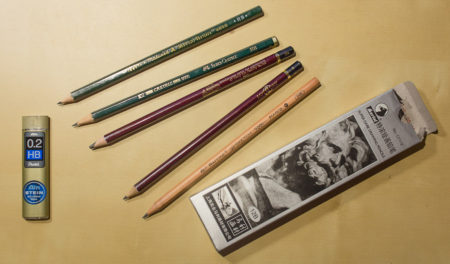
I have added the Orenz 0.3 to my sliding sleeve table.
Prices: December 2015
Exchange rates: January 2016
The background of the first photos is a tribute to Lexikaliker, who kindled my interest in the Orenz – just that my background isn’t a Tenugui, but a Furoshiki – in my case a non-woven wrapping sheet from Muji.
I have discussed the Indonesian version of the Castell 9000 in a previous blog post.
To see the Orenz in its full beauty please open the Orenz images (the first three) in a new tab/window.
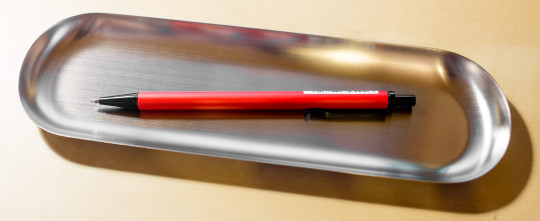
One of the pencils I bought in Shanghai this Winter is the M&G m9, also known as the AMP85405.
When I saw it in a stationery store [1]I think it was 立信帐册, house number 618, even though according to Google it is somewhere else. on FuZhou Road, the book and stationery road I mentioned many times before, I just couldn’t resist. Only 15元 (~$2.30; $1.60; €2.10) for this quite handsome mechanical pencil. It is available in white, grey, red and black. It feels very well made, from some kind off metal, and with 12 g it is quite heavy for it’s size. The pen’s centre of gravity is in the middle.

It does feature a sliding sleeve, but the ‘sleeve’ is shaped more like a cone than like a pipe. This means that it is not good at what I like sliding sleeves for, i.e. sliding back while you write so that you don’t have to keep advancing the lead manually, despite only needing 4 dN – 6 dN to slide the sleeve.

Great value for money, despite the sliding sleeve not doing its job properly. I think the m9 might benefit from its centre of gravity a bit closer to the front …and maybe from having a slightly larger diameter.
Price: December 2015
Exchange rates: January 2016
You can read about a wood-cased pencil from M&G in a previous blog post.
I have added the m9 to my sliding sleeve table.
References
| ↑1 | I think it was 立信帐册, house number 618, even though according to Google it is somewhere else. |
|---|